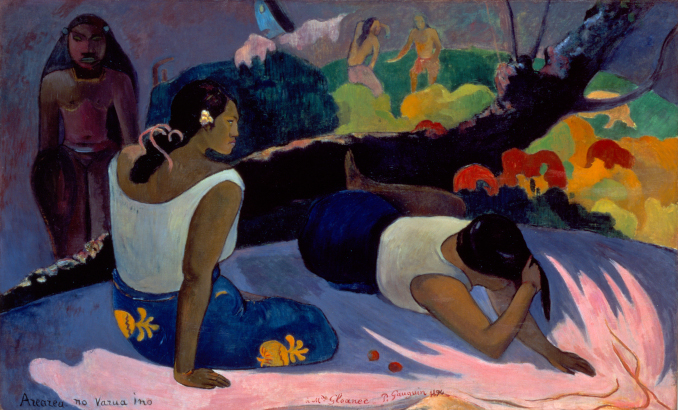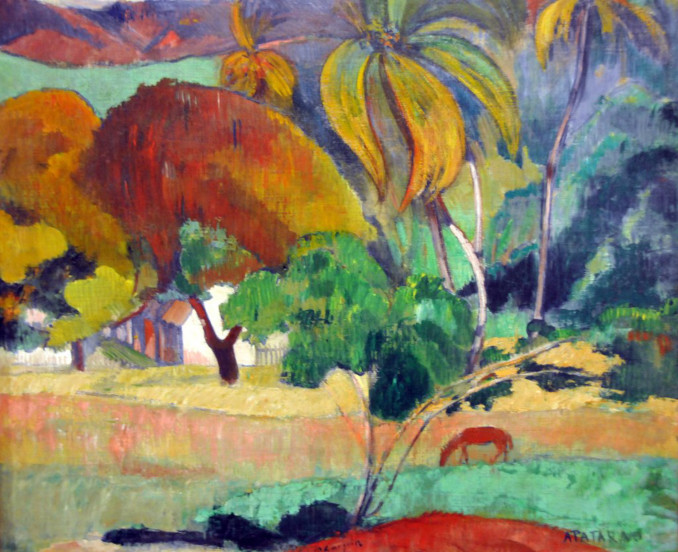Food for the Soul: De Young Museum Part 1 – Gauguin

“There is always a heavy demand for fresh mediocrity. In every generation the least cultivated taste has the largest appetite.” Paul Gauguin
By Nina Heyn – Your Culture Scout
By all accounts Paul Gauguin was not a nice man. In his quest for artistic expression he abandoned his long-suffering wife and kids, he practically drove the unstable van Gogh to self-mutilation, he fathered and abandoned illegitimate children with his servant and scores of Tahitian women during his stay in a tropical paradise. What he lacked as a caring human being, he made up as a creative force, making huge strides from a self-taught painter, to an accomplished impressionist, and finally to a thoroughly modern artist that bridged impressionists’ discoveries of light and color that were still rooted in representational art towards a new way of treating images soon to become an abstract art. So, as much as there is little to admire in him as a man, there is a lot to explore about his as an artist.
A current exhibition at the exquisite San Francisco’s De Young Museum is indeed exploring the artist’s development in a presentation called Gauguin: A Spiritual Journey and as its title indicates, it is focused in Gauguin’s interest in spiritual matters. Many of his famous paintings, especially the ones with the crucified Christ and the famous Vision After the Sermon-Jacob Wrestling with an Angel attest to his early and frequent interest in religious references. Even some of his Pacific phase paintings have religious titles of such as “Nativity” when portraying Tahitians in their local environment. De Young’s exhibition reaches into his spiritual inspirations by juxtaposing Pacific Islander carvings of ancestors and idols with Gauguin’s symbolism.
The bulk of the presentation comes from Danish Ny Carlsberg Glyptotek with some of De Young’s own collection added on, featuring his fairly unknown ceramics and wood carvings next to his paintings of all his artistic phases, and a wide documentation of his letters and other writings as well as family photographs and other references.
One of the most interesting aspects of this exhibition is that seeing Gauguin’s paintings from various periods of his life allows an insight into his astonishing evolution from impressionism to a new language that is unmistakably his own. This can be traced for example through the following three pictures.

Gauguin painted Landscape with Tall Trees in 1883 when he was strongly under the influence of his mentor Camille Pissarro. The way he dabbed brush strokes and used this autumnal color palette are reminiscent of many impressionist pictures of the time, with Pissarro’s work, or Sisley or even early Monet being good examples. Once Gauguin discovered Brittany, his outlook on painting has changed. He was no longer interested in giving “impressions” of what he saw outdoors. “A hint- don’t paint too much direct from nature. Art is an abstraction; draw it out from nature while dreaming upon it and concentrate more on the creative process than on the result, that’s the only way to come close to God, namely doing the same as our divine master, creating,” says Gauguin in 1888 in a letter to a friend. His painting style changes correspondingly – he paints symbolic pictures, mysteriously posed women in exotic costumes (an almost mystical composition Landscape from Brittany with Breton Women in presented in this exhibition). The people he paints are no longer actual portraits but a symbolic figures positioned to serve a meaning or a part composition. His style changes markedly- there are now black outlines influenced by “japonisme,”or “cloissonisme,” and these large swaths of flat color will become Gauguin’s new, preferred way of conveying color and shape.

And finally, we have Tahitian landscapes, as represented in the exhibition by the 1893 painting Landscape from Tahiti, Apataroa and the 1894 gorgeous if rarely seen Reclining Tahitian Women. Gauguin himself was saying of these new images: “I am trying to put into these desolate figures the savagery that I see in them and which is in me too… Dammit, I want to consult nature as well but I don’t want to leave out what I see there and what comes into my mind.” These are familiar “gauguinesque” images in his unique style: the saturated blue-green of foliage, strong black outlines, and flat panes of landscape in lush but non-realistic colors. This is the Gauguin that is instantly recognizable, fascinating, perennially a favorite, and a precursor of the 20th century art. So many painters have dipped into his stylebook- Henri Matisse, Pablo Picasso, David Hockney, Richard Diebenkorn, the fauvists, the primitivists…the list can go on.

De Young Museum, together with Legion of Honor Museum, is a part the Fine Arts Museums of San Francisco – the largest art institution in that city, and it is FAMSF first exhibition dedicated to Gauguin. It is not easy to normally access some of the best of Gauguin’s art, since apart from the Danish Glyptoteke collection that FAMSF is featuring, the other large depository outside France is located in Russian museums. Therefore, this loan exhibition that San Francisco organized with Denmark it is a rare opportunity to see paintings that have been making history of art for over a hundred years.
Check It Out!
